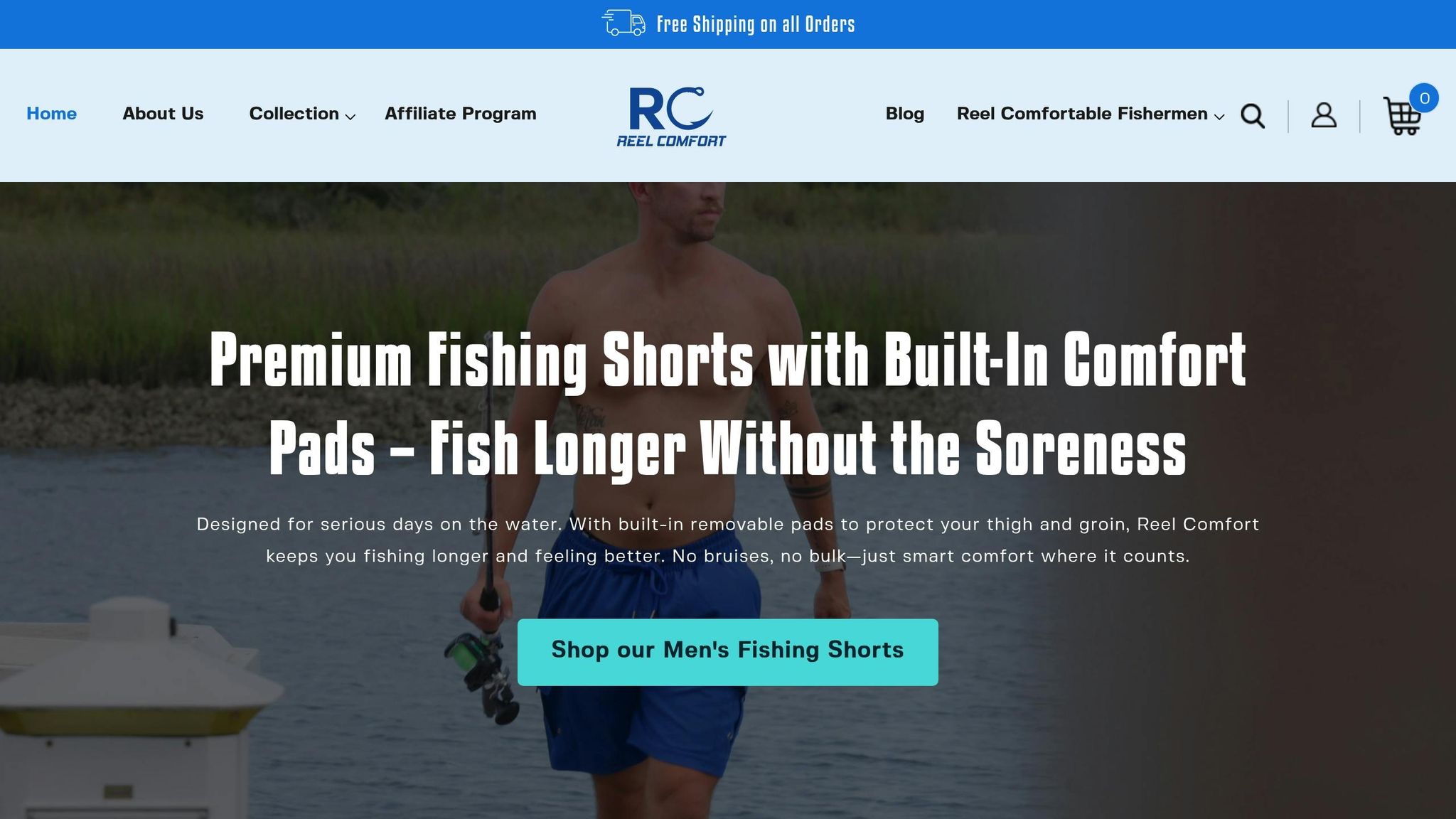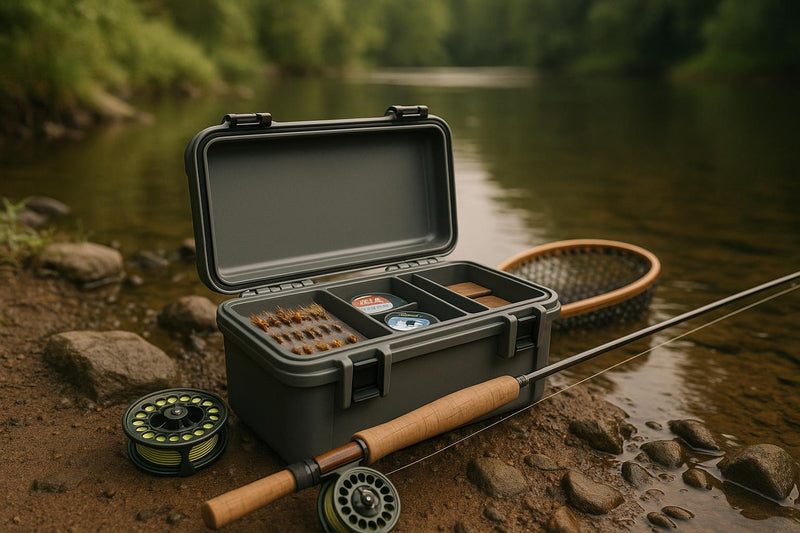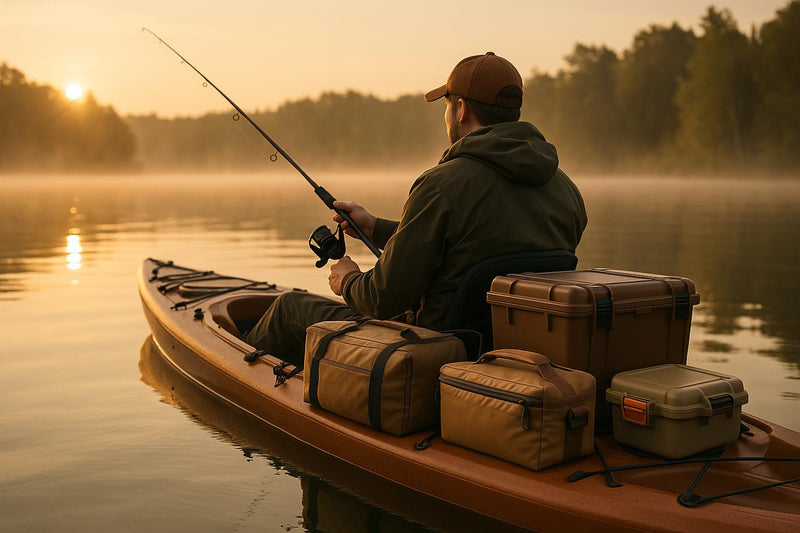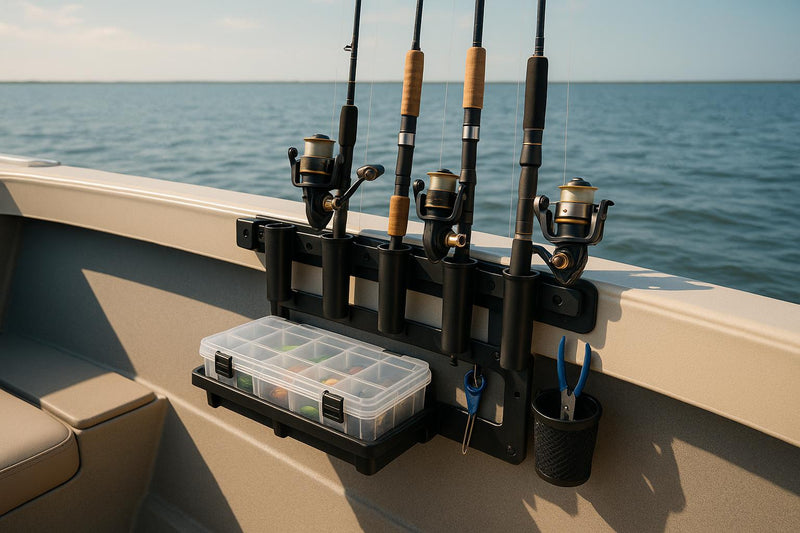When it comes to waterproofing your fishing gear, you have two main options: sprays and wash-in treatments. Both methods create a water-repellent barrier while keeping the fabric breathable, but they differ in application, coverage, durability, and convenience. Here’s a quick breakdown:
- Sprays: Ideal for quick touch-ups and targeting specific areas like seams or high-wear spots. They’re easy to apply but require more frequent reapplication.
- Wash-In Treatments: Provide full coverage by bonding with fabric fibers during a wash cycle. They last longer but need more time and planning to apply.
Choosing the right method depends on your needs. Sprays are great for immediate fixes, while wash-in treatments offer longer-lasting, all-over protection. For best results, many anglers combine both methods to keep their gear ready for any conditions.
Waterproofing Sprays: How They Work and What to Expect
How Waterproofing Sprays Work
Waterproofing sprays create a protective layer on your fishing shorts by filling the fabric's pores with water-repellent chemicals. This coating causes water to bead up and roll off, instead of soaking into the material. The key is the Durable Water Repellency (DWR) coating, which blocks the natural absorption process of fabrics. The best sprays strike a balance - they form a semi-porous barrier that keeps water out while allowing your gear to remain breathable. This breathability is essential for staying comfortable during those long fishing trips.
To apply, spray evenly on clean, damp fabric, holding the can about six inches away. Use slow, sweeping motions and apply two light coats for the best coverage. Allow 24–48 hours for the treatment to fully cure. This quick and straightforward method is perfect for enhancing your gear’s water resistance without much hassle.
Advantages of Waterproofing Sprays
Quick and Easy Application. Waterproofing sprays are incredibly convenient. You can apply them in just minutes, making them perfect for last-minute touch-ups before heading out on a fishing trip or when you notice your gear starting to absorb water.
Works on a Variety of Materials. These sprays are versatile and can be used on almost any waterproof or breathable fabric. Whether it’s your Mens Fishing Shorts, rain jacket, or fishing hat, one product can handle it all.
Prolongs Fabric Durability. By reducing wear and tear caused by water exposure, these sprays help extend the life of your gear. For high-quality items like Reel Comfort’s quick-dry fabric technology, this added durability is a huge plus.
Easy Maintenance. If your water-resistant gear starts losing its effectiveness, a quick reapplication of the spray can restore its protective qualities - no need for a full wash.
Keeps Gear Comfortable. High-quality sprays maintain the breathability and natural feel of your fishing shorts, so you stay comfortable even during long, active days on the water.
Disadvantages of Waterproofing Sprays
One downside is that the DWR coating doesn’t last forever. Regular wear, washing, and exposure to oils and dirt can gradually reduce its effectiveness, meaning you’ll need to reapply the spray periodically. Another consideration is the curing time - most sprays require up to 48 hours to fully set, which can be a hassle if you need your gear ready in a hurry.
Wash-In Treatments: How They Work and What to Expect
How Wash-In Treatments Work
Wash-in treatments take a unique route to waterproofing by integrating the protective agents directly into the washing process. Unlike sprays that coat the surface, these treatments work their way into the fabric fibers during a wash cycle, creating water repellency from the inside out. The active ingredients bond with the material, restoring and reinforcing the DWR (Durable Water Repellent) coating. This ensures water beads off the fabric while keeping its breathability intact.
The application is simple: add the wash-in treatment to your washing machine with your clean Fishing shorts and run a normal cycle - no detergent needed. The agitation and water flow ensure the treatment reaches every fiber, seam, and stitch. Once done, tumble dry on a warm, delicate setting or air dry. Avoid high heat, as it can damage the fabric. This method provides consistent, all-over coverage, unlike the spot-specific application of sprays.
Advantages of Wash-In Treatments
-
Even Coverage Everywhere
The wash cycle ensures the treatment coats every part of the garment, including hidden seams and pocket linings, for thorough waterproofing. -
Treat Multiple Items at Once
Wash-in treatments are perfect for waterproofing several pieces of clothing in one go, making them ideal for anglers who need to prep an entire outfit. -
Deep Fabric Penetration
These treatments bond deeply with fibers, offering long-lasting protection. This is especially effective for synthetic materials like those used in Mens Fishing Shorts and other technical gear. -
Seam and Stitch Protection
The wash process ensures vulnerable areas - such as seams, zippers, and stitching - receive the treatment, helping maintain water resistance where it’s needed most. -
Designed for Technical Fabrics
Tailored for advanced outdoor materials like GORE-TEX® and Event®, wash-in treatments improve water repellency without compromising breathability.
Disadvantages of Wash-In Treatments
While wash-in treatments provide durable, even waterproofing, they do require a dedicated wash cycle and careful drying. This makes them less convenient for quick fixes or touch-ups when you're already out on the water.
Side-by-Side Comparison: Sprays vs Wash-In Treatments
Key Comparison Factors
When it comes to waterproofing your Fishing shorts, the choice between sprays and wash-in treatments depends on your gear and how you use it. Each method has its strengths, so picking the right one can make all the difference.
Application method is the most noticeable difference. Sprays let you focus on specific areas, like knees or pocket seams, which tend to see the most wear. Wash-in treatments, on the other hand, provide full coverage by running your gear through a washing machine. This is especially helpful for garments made with multiple fabric types.
Coverage precision is another key factor. Sprays are great for touching up high-use areas or refreshing waterproofing where it’s worn off. Wash-in treatments, however, deliver even protection across the entire garment, including tricky spots like interior seams and zippers.
The impact on breathability also varies. Sprays form a layer on the fabric's surface, which might reduce airflow if over-applied. Wash-in treatments work within the fibers, helping preserve the fabric's original breathability. This is especially important for technical fishing gear, which needs to stay comfortable during long, warm days on the water.
Reapplication frequency depends on how often you use and wash your gear. Sprays need more frequent touch-ups, especially in high-friction areas, but they’re quick and easy to apply. Wash-in treatments last longer but require planning since you’ll need to run a full wash cycle.
For padded or multi-material garments, such as fishing shorts with removable thigh pads or multiple fabric panels, wash-in treatments ensure consistent protection across all sections. Sprays might leave some interior areas untreated or create uneven coverage.
Here’s a quick breakdown of these factors:
Comparison Table
| Factor | Waterproofing Sprays | Wash-In Treatments |
|---|---|---|
| Application Time | 5-10 minutes | 60-90 minutes (including wash/dry) |
| Coverage Type | Targeted, surface-level | Full fiber penetration |
| Best For | Quick fixes, specific areas | Full garment refresh |
| Frequency Needed | Every 2-4 weeks with heavy use | Every 2-3 months |
| Cost Per Treatment | $0.50-$1.00 per garment | $1.50-$2.50 per load |
| Fabric Compatibility | Most synthetic materials | Technical fabrics, DWR coatings |
| Breathability Impact | Minimal if applied correctly | Maintains original properties |
| Convenience | High (anytime application) | Medium (requires wash planning) |
| Durability | 10-15 wash cycles | 20-30 wash cycles |
| Multi-Item Treatment | Needed individually | Multiple items per cycle |
Ultimately, the right choice depends on your needs. Anglers looking for quick touch-ups often prefer sprays, while those who want long-lasting, all-over protection tend to go with wash-in treatments. Many seasoned anglers find that combining both methods gives them the best of both worlds, depending on the situation and timing of their fishing trips. This balance ensures your gear stays in top shape, ready for whatever the water throws your way.
sbb-itb-cb0a783
Choosing the Right Method for Your Fishing Shorts
What to Consider Before Choosing
Picking the best waterproofing method for your fishing shorts depends on the design and how you use your gear. The type of fabric plays a big role - quick-dry synthetic materials, for example, tend to work well with both spray and wash-in treatments. Wash-in treatments, however, penetrate deeper into the fibers, offering more thorough protection.
The way your shorts are constructed is just as important. For instance, Reel Comfort fishing shorts with multiple fabric panels, reinforced seams, or removable padding need a method that ensures full coverage. Shorts with ergonomic seams or four-way stretch panels benefit greatly from wash-in treatments, which provide even protection across all areas.
How often you fish also matters. If you’re a casual angler heading out once or twice a month, a quick spray treatment might do the trick. But if fishing is a regular part of your life, wash-in treatments provide the lasting protection you’ll need. And don’t forget to consider the environment - saltwater fishing often demands more durable waterproofing than freshwater outings.
Lastly, think about your maintenance habits. Sprays are perfect for last-minute touch-ups, while wash-in treatments require a little more planning since they involve a full wash and dry cycle. All these factors influence how well your waterproofing method will perform.
Best Practices for Reel Comfort Products

Reel Comfort products, like their Men's Fishing Shorts, come with features like removable thigh pads, quick-dry fabric, and built-in water resistance. These details call for a specific waterproofing approach to keep your gear in top shape.
For the shorts themselves, wash-in treatments work seamlessly with their quick-dry fabric. Be sure to remove the thigh pads before applying the treatment to ensure every part of the shorts gets even coverage. For the thigh pads, which see more wear and tear, sprays are a convenient way to add a quick layer of protection between more thorough waterproofing sessions.
The shorts’ deep hand pockets and zippered back pockets are tricky to reach with sprays, making wash-in treatments a better option for these areas. The wash-in solution soaks into the entire garment, helping keep those storage spaces dry for essentials like your phone or keys.
Reinforced stitching and rip-stop fabric handle both treatment types well, but seam areas deserve extra attention when using sprays since they can be more vulnerable. Wash-in treatments naturally address these spots more effectively.
To maintain the water resistance of your Reel Comfort shorts, align your waterproofing treatments with your regular washing routine. This ensures the fabric stays protected without overdoing it, helping your gear last longer and perform better.
Reel Comfort shorts, available in black, gray, and blue, retain their vibrant colors with proper care. Always let your gear dry completely before storing it, and keep it in a cool, dry place away from direct sunlight to protect both the waterproofing and the fabric itself.
For additional care tips and to make the most of your Reel Comfort fishing shorts, check out the product care guidelines. With a little effort, you’ll be ready for your next fishing trip with gear that performs just as it should.
Common Mistakes and How to Avoid Them
Most Common Waterproofing Mistakes
One common misstep is using regular laundry detergent on waterproof gear. These detergents leave residues that clog fabric pores, stopping water from beading and reducing the effectiveness of Durable Water Repellent (DWR) coatings. Many supermarket detergents attract water and oils, which further disrupt the waterproofing process. Even the best waterproofing treatments won’t work properly on your Fishing shorts if residues are left behind.
Another mistake is applying waterproofing treatments to dirty gear. Dirt and other residues block absorption, preventing the treatment from bonding with the fabric. Instead of soaking in, the product sits on the surface, leading to uneven protection. This is especially problematic for Reel Comfort Mens Fishing Shorts, which feature quick-dry fabric technology that relies on proper treatment for optimal performance.
Using the wrong waterproofing product can also cause issues. Some products are incompatible with certain fabrics, clogging breathable membranes or leaving gear greasy and stiff. For multi-layered garments, wash-in treatments can coat interior layers, reducing breathability.
Incorrect application is another pitfall. Applying the treatment too quickly, unevenly, or using the wrong amount can leave parts of the fabric untreated, resulting in patchy coverage and stiff areas that still absorb water.
Over time, waterproofing treatments naturally degrade due to wear and tear, UV exposure, dirt, and oils. DWR coatings break down from rain, mud, body oils, sunscreen, smoke, bug spray, and daily use. While these coatings are durable, they’re not permanent.
Finally, rushing to use gear before the treatment fully cures weakens the protective barrier. Waterproofing products need time to bond with fabric fibers to provide effective protection. Skipping this step compromises their performance.
Avoiding these mistakes is crucial to keeping your gear in top condition. The following maintenance tips can help ensure long-lasting results.
Maintenance Tips for Long-Lasting Results
Once your gear is properly treated, maintaining it becomes the key to extending its waterproofing performance. Start by using technical wash products specifically designed for outdoor gear. These cleaners remove dirt and oils without leaving residues that interfere with waterproof coatings.
Establish a cleaning routine to preserve your gear. After saltwater trips, rinse your Reel Comfort Fishing shorts with fresh water to remove salt that can damage fabric fibers. After several outings, wash thoroughly to prevent salt crystals from accumulating over time.
Store your gear in a cool, dry place away from direct sunlight. UV rays are one of the fastest ways to break down fabric fibers and waterproof coatings. Also, avoid packing damp gear into tackle boxes or storage bags, as trapped moisture can lead to mildew and further damage.
Keep an eye on your gear’s performance. When water stops beading on the surface, it’s time to reapply a waterproofing treatment. Don’t wait until your shorts are completely soaked - early intervention with spray treatments can help prolong the time between full wash-in applications.
For a quick boost, revive DWR coatings by tumble drying your gear on medium heat for 15–20 minutes. This step often restores water beading on coatings that have been flattened by regular use but aren’t fully worn out.
Lastly, always follow the instructions provided with your waterproofing products. Each product has specific guidelines for application, dilution, and curing times. Taking the time to apply treatments correctly not only saves effort but also extends the lifespan of your gear significantly. These steps reinforce the importance of careful application and consistent maintenance for maximum performance.
Final Thoughts: Which Method is Right for You
Waterproofing sprays and wash-in treatments each have their strengths, and the best choice depends on what you need. Sprays are perfect for quick touch-ups, precise application, or targeting specific high-wear areas without the hassle of a full wash. They’re especially handy for refreshing the water repellency of your Fishing shorts between trips.
On the other hand, wash-in treatments offer deeper, longer-lasting protection by soaking into the fabric fibers. This makes them a great option for Reel Comfort's Mens Fishing Shorts, as they ensure even coverage, including seams and pockets - places sprays might miss.
Ultimately, the right method depends on how you use your gear and the conditions you face. For anglers on a budget, combining a wash-in treatment as a base with occasional spray touch-ups can deliver excellent results, especially for extended outings in tough saltwater environments. Meanwhile, weekend anglers in calmer conditions might find sprays alone do the job.
Whichever method you choose, proper application and care are essential. Clean your gear before treatment, stick to the manufacturer’s instructions, and give the treatment enough time to set.
Think about what works best for your routine, budget, and performance needs. Both methods will help protect your fishing gear and keep it in top shape. For more tips and gear options, check out Reel Comfort's collection of Fishing shorts and get ready to make the most of your next fishing trip!
FAQs
What’s the best way to waterproof my fishing shorts: spray or wash-in treatment?
When deciding between waterproofing spray and wash-in treatments, it all comes down to what you need and how your fishing gear is designed. Spray-on waterproofing works great for applying to specific areas, especially outer surfaces and spots that see a lot of wear. It helps preserve breathability and comfort, making it a quick and straightforward choice for targeted use. On the flip side, wash-in treatments coat the entire garment, inside and out, offering full coverage. However, they can sometimes affect breathability and may use more product than necessary.
For fishing shorts, spray-on waterproofing is typically the way to go. It boosts water resistance while keeping comfort and mobility intact - perfect for those long days spent out on the water.
What mistakes should I avoid when applying waterproofing treatments to fishing shorts?
To get the most out of waterproofing treatments for your fishing shorts, it’s important to avoid a few common missteps. One frequent mistake is using the wrong type of product. For instance, opting for a spray-on treatment when a wash-in product is better suited can result in poor waterproofing or even block the fabric’s breathability. Always pick a treatment that matches your shorts’ material and specific requirements.
Another error people often make is skipping the cleaning step before applying the treatment. Dirt and residue left on the fabric can interfere with how well the waterproofing works. Overapplying the product is another pitfall - it can damage the material or make it uncomfortably stiff. To get the best results, follow the manufacturer’s instructions carefully, use the recommended amount, and reapply the treatment as needed, especially after heavy use or washing.
Can I use both waterproofing sprays and wash-in treatments together to protect my fishing shorts?
When it comes to keeping your fishing shorts dry and comfortable, combining waterproofing sprays with wash-in treatments can be a smart move. Here’s how it works: a wash-in treatment penetrates the fabric, enhancing water resistance from the inside out. Meanwhile, a spray-on treatment adds an extra protective layer to the outer surface, focusing on areas that experience the most wear and tear.
To get the best out of this combo, make sure to carefully follow the application instructions for both products. This ensures you don’t accidentally affect the fabric’s breathability or durability. This dual approach is especially handy for fishing shorts that face constant exposure to damp or wet conditions, helping them stay dry and ready for action longer.




